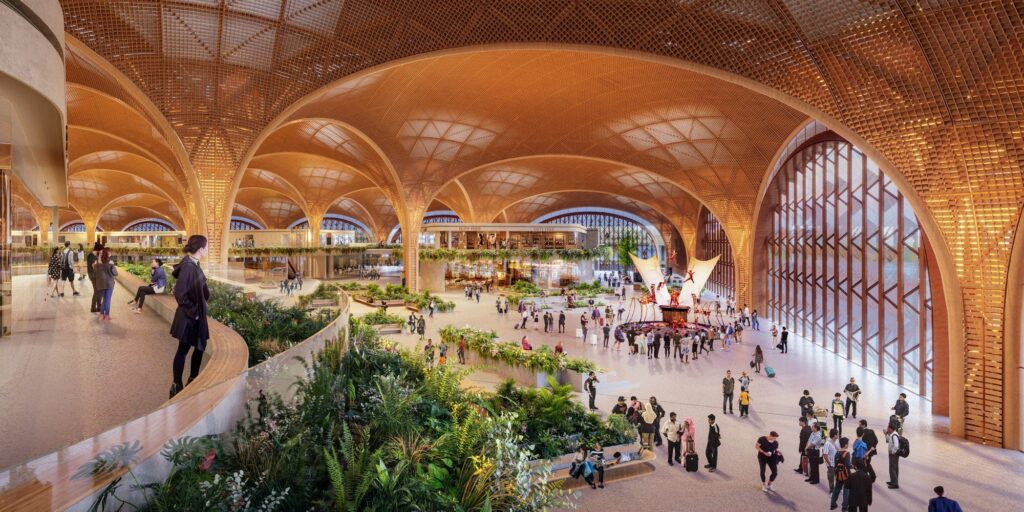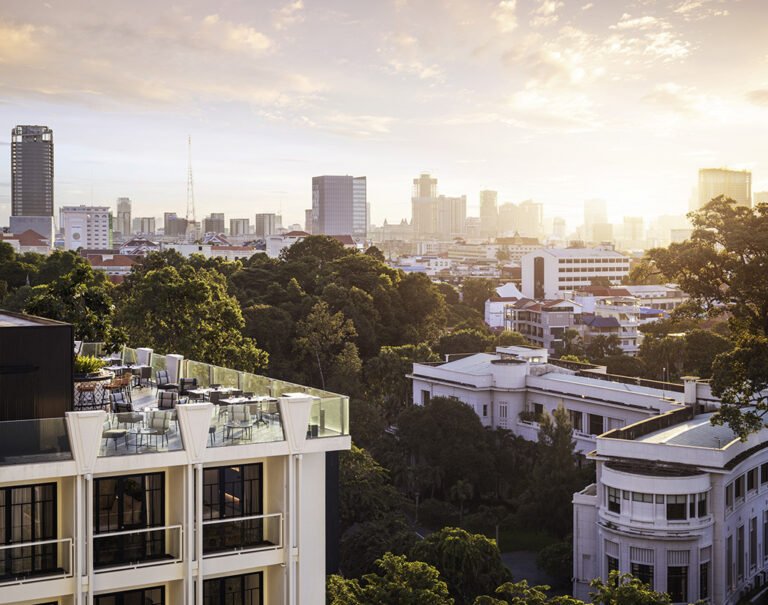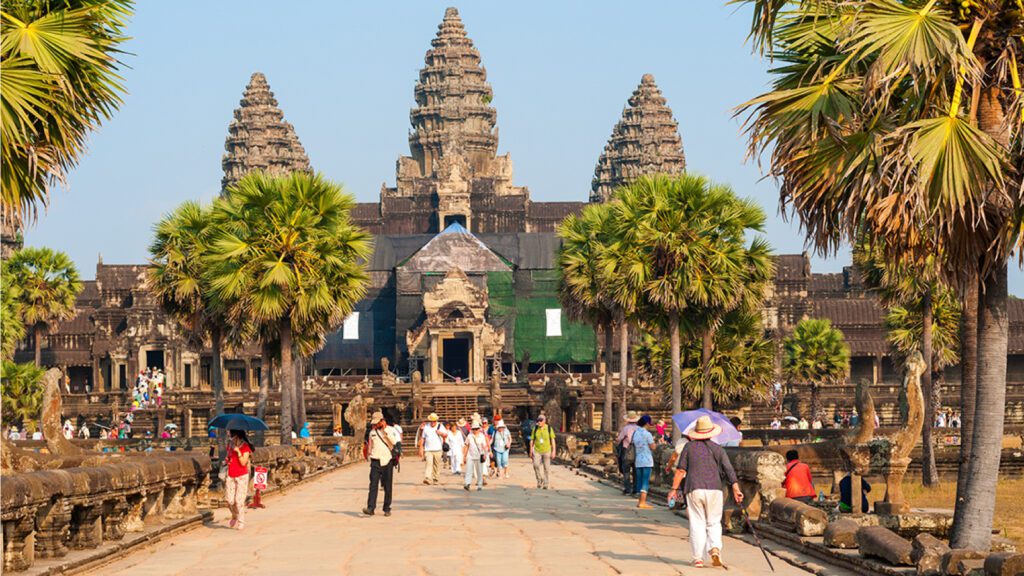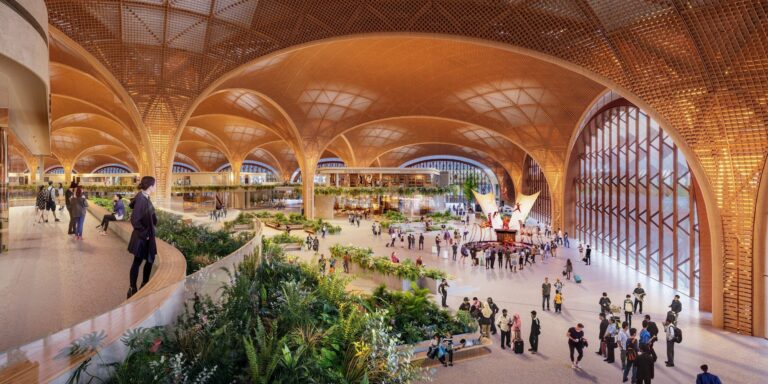Cambodia’s $3 billion international airport has just opened.
Cambodia’s $3 billion airport promises sleeker more efficient international arrivals, and when at its peak will handle up to 50 million passengers every year.
Earlier this year I landed in Cambodia to a slick new airport in Siem Reap and it was a bit of a shock to the system. It was a long way further from town than the previous airports (about 50 minutes compared to 15), and it was quite the modern monstrosity in a country known for temple ruins and quaint Asian design.
And the new one which has just opened on the outskirts of Phnom Penh, sounds like an even more futuristic and modern landmark rising from the Cambodian plains. It looks sleek, modern, and laden with symbols of national pride including a striking 9-metre golden Buddha greeting passengers, a ceiling inspired by jungle canopies, and architecture that draws on the curves and geometry of traditional Khmer temples.

This is Techo International Airport—a $US2 billion (about $A3.05 billion) aviation masterpiece expected to redefine Cambodia’s role in regional travel.
Located about 20 kilometres south of Phnom Penh in Kandal province’s Takhmao district, Techo International Airport is more than an infrastructural upgrade—it represents Cambodia’s most ambitious project to date in the international travel and aviation sector.
It isn’t merely an architectural feat—it’s a statement of confidence. From its Foster + Partners gleam to its symbolic golden Buddha, the project signifies how a small nation still writing its development story after a dramatic and torrid past can project itself onto the world stage.

As travellers roll their luggage through the vast glass atriums, perhaps pausing for a selfie beneath the sweeping bamboo canopy, they stand within Cambodia’s most tangible vision of the future: one shaped by ambition, artistry, and a deep-rooted belief that prosperity can take flight from the heart of Southeast Asia.
Developed over a vast area of 2,600 hectares, the new airport officially opened its first phase in late September 2025 after six years of construction, replacing the aging Phnom Penh International Airport. At full capacity, Techo is expected to handle up to 50 million passengers annually by 2050, making it one of Southeast Asia’s largest air transport hubs.
Click here to read why you should stay at The Sofitel Siem Reap in Cambodia.

Tourism and Trade Ambitions
For Cambodia, Techo International Airport is a critical step toward reclaiming the tourism engine that fueled its economy before the pandemic. The old Phnom Penh International Airport could handle around 5 million passengers annually—less than a third of Techo’s current operating capacity. With this expansion, Cambodian officials expect to triple visitor entries within five years.
The Cambodian tourism ministry projects the new airport will facilitate not only increased visitor arrivals but also serve as a pivotal connector for cargo and trade routes across Southeast Asia. As neighbouring Thailand, Vietnam, and Singapore vie for dominance as regional aviation hubs, Techo provides Cambodia with leverage—especially in emerging market routes linking Australia, India, and southern China.
Indeed, the Cambodian government has signed new bilateral air service agreements with a number of nations, including Australia, paving the way for future non-stop flights between Phnom Penh and Sydney or Melbourne. This could radically reduce transit times for business travellers and tourists alike who currently connect via Bangkok or Singapore.

Click here for more on Raffles Siem Reap.
Design and Technology: A Blend of Khmer Soul and Global Innovation
The architectural design was conceived by renowned British firm Foster + Partners, which also designed Abu Dhabi’s upcoming Zayed National Museum and Hong Kong’s Chek Lap Kok airport extension.
The studio drew inspiration from Cambodia’s heritage, infusing traditional Khmer symbolism with cutting-edge sustainability. The roofline, fluted and organic, resembles flowing silk. Beneath it lies a vast terminal filled with bamboo-patterned skylights and natural light, echoing the tropical forests beyond the runway.
Inside, vertical gardens explode with native flora. Soft gold and bronze accents are offset by modern stone finishes. The terminal’s centrepiece—a golden Buddha in the abhayamudra pose—represents protection and serenity for travellers. Its presence anchors the design in Cambodian spirituality even as planes from around the world dock outside.
Foster + Partners also integrated ambitious environmental goals. Most energy needs are met through an on-site solar farm, and rainwater harvesting systems minimise water waste. The project aligns with Cambodia’s sustainability plan to reduce fossil fuel dependence by 40 percent before 2030.
Click here to read about the Bensley Villas, an exceptional place to stay in Cambodia.

Local Impact and Public Reception
Opening week at the airport resembled a festival. Local residents flooded the terminals to explore the luxurious public spaces before normal operations began.
The last day of free parking drew lines stretching for kilometres as Cambodians posed for selfies beside the golden Buddha or dined at international outlets such as Burger King, Starbucks, and Krispy Kreme.
Airport employees, many newly trained by OCIC and the SSCA, see Techo as a symbol of national progress. “I never thought I’d work in a place as beautiful as this,” said Sokha, a customer service agent from Kandal province. “It makes us proud to show what Cambodia can do.”
Of course, not everything has gone smoothly. Critics have raised concerns about land acquisition and resettlement for villagers displaced during the construction phase, though OCIC maintains that compensation packages and relocation support were provided. Environmental advocates have called for stronger assurances that the massive solar panels and urban footprint won’t disrupt surrounding wetlands.
Click for a fascinating podcast conversation with Rosewood Phnom Penh General Manager Daniel Simon

Beyond the Runways: A City within a City
Techo International Airport isn’t just an air hub—it’s the centrepiece of a planned “aerotropolis”, a development model integrating commercial, residential, and industrial zones around a major airport. Future phases include luxury hotels, logistics parks, and a dedicated airport city connected to central Phnom Penh by expressway and potential light rail.
At capacity, airport authorities expect to host 15 to 20 international carriers and welcome up to 200,000 flights per year. Already, regional airlines such as Cambodia Angkor Air, Emirates, and AirAsia have expressed interest in establishing routes.
For Neak Oknha Pung Khiev Se and his OCIC empire, Techo International Airport marks a generational achievement—an enduring legacy that fuses Cambodia’s aspirations with global ambition. In interviews, Pung often describes the project as “for the people”—a way to unlock Cambodia’s geographic advantage in ASEAN and bring modern infrastructure home.

Who Owns Cambodia’s New Showpiece
Unlike many airports funded purely through state expenditure or foreign loans, Techo International Airport was developed through a public–private joint venture. The project is operated by Cambodia Airport Investment Co., Ltd. (CAIC), a special-purpose company jointly owned by Overseas Cambodian Investment Corporation (OCIC)—a private conglomerate chaired by Neak Oknha Pung Khiev Se—and Cambodia’s State Secretariat of Civil Aviation (SSCA).
Pung Khiev Se is one of Cambodia’s most prominent businessmen and a key figure in the country’s modern development story. Born in Kampong Cham province, he built his fortune through banking, real estate, and construction before becoming founder of OCIC and owner of Canadia Bank, one of the nation’s largest financial institutions. His business ventures have helped shape Phnom Penh’s skyline: Diamond Island (Koh Pich), the Canadia Tower, and now the Techo International Airport all bear his group’s imprint.
The Pung family’s headquarters are based in Phnom Penh, close to the Bassac River. Though OCIC is Cambodian-owned, development of Techo International Airport has attracted significant foreign expertise and capital.
Chinese construction giants—China Construction Third Engineering Bureau and China State Construction Engineering Corporation (CSCEC)—were contracted for major building works. Financing assistance also came via the China Development Bank, underscoring the deep economic ties between Phnom Penh and Beijing.
This isn’t the first time OCIC has partnered with Chinese entities on mega-infrastructure. The company’s previous projects include major urban developments and bridges funded under China’s Belt and Road Initiative. But Techo International Airport, with its global design pedigree and World-Class operational goals, stands as a uniquely Cambodian-led project intended to showcase national capability.




